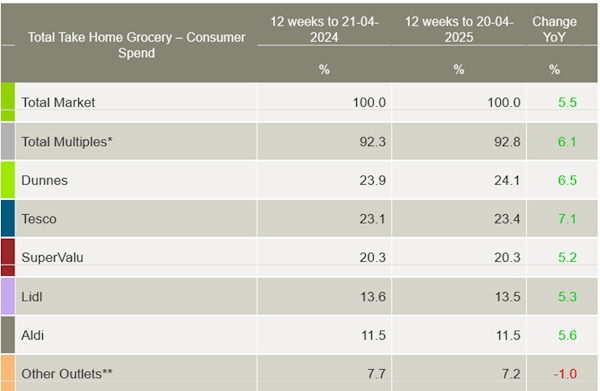Latest data from Kantar shows that take-home value sales in Ireland’s grocery market surged up 8.4% during the four weeks to 20 April. Sales benefited from Easter falling later this year, with increased store visits (23 on average) by shoppers contributing an additional €9.7m to the market’s overall performance.
Grocery price inflation also rose this month and currently stands at 4.91% – up 2.52 percentage points compared to last year.
“Despite average prices continuing to rise, it’s clear that Irish consumers are still treating themselves,” said Emer Healy, Business Development Director at Kantar.
“With Easter falling late this year, it’s been a real boost for retailers who have benefited from special occasions including St Patrick’s Day, Pancake Day, Easter and the forthcoming May bank holiday.”
Over the latest 12-week period, an additional €15.3m was spent on seasonal Easter confectionery, with 82% of this attributed to Easter eggs alone. Shoppers also purchased more Easter eggs than last year, up 6.6%, with over 64% of Irish households buying one this year. Notably, 43% of all Easter egg sales were made on promotion.
Promotional sales were not just for Easter Eggs. The total grocery market in Ireland saw an increase in promotions by 15.4% in the 12 weeks, with shoppers spending an additional €109m on promotional lines versus the same period last year. Promotional sales currently hold 22.8% of total grocery spending compared to 20.8% last year.
“Price influences decisions, but it’s clear that Irish shoppers still cherish quality, particularly when it comes to special occasions that bring people together and create lasting memories,” Healy added.
“This is evident with both branded (5.6%) and premium own label products (9.7%) growing faster than the market as a whole (5.5%). Our data shows that shoppers spent an additional €102m on these two ranges compared to last year. Brands continue to hold a higher value share of the total market with 47.7%, while own label holds 46.9%. Ultimately, retailers need to demonstrate clear value to customers, but it’s a tricky balance especially as they are trying to manage their own rising business costs.”
April also saw a steep increase in alcohol sales, up 8.7% year-on-year. Shoppers spent an additional €8m on beer and cider, wine and non-alcoholic drinks versus last year. And brighter and warmer days boosted the performance of typical BBQ choices with an extra combined €1.1m spent on sausages, antipasti, coleslaw and potato salad in April.
Over the 12-week period, online grocery sales were boosted by a 10% increase in shopping frequency and an influx of new customers. More than 18% of Irish households shopped online for groceries during this time, with new shoppers and more frequent trips contributing a combined €22.8m to overall performance.
Looking at the performance of individual retailers, Dunnes’ market share rose to 24.1% after it saw sales growth of 6.5%. The chain’s shoppers picked up more volume per trip, up 2.2%, as well as making more frequent trips, up 0.8%, which contributed a combined €24.4m to its overall performance.
Tesco held 23.4% of the market, with value growth of 7.1% year-on-year. Shoppers increased their trips to its stores by 4.2%, contributing €32.5m to overall performance.
SuperValu controlled 20.3% of the market with growth of 5.2%. Consumers made the most shopping trips to this grocer, averaging 24.5 trips over the 12 weeks. This increase in the number of shopping trips contributed an additional €37.2m to its performance.
Lidl’s share was 13.5% after delivering growth of 5.3%, with larger trips driving an additional €10.7m in sales. Aldi maintained its 11.5% share after seeing growth of 5.6%, with increased trips to its stores driving an additional €19.6m in sales.

NAM Implications:
- The key standout has to be the combined discounters’ share being 25%…
- …despite the strengths of the mults and their ability to increase appeal via promotions.
- Meanwhile, consumers are coping with high inflation by some switching to premium own label.
- This means that brand equivalents are at risk of ‘permanent’ loss of some loyals…
- …should the ‘switchers’ find the own label to be less of a compromise than brand advertising led them to expect.



